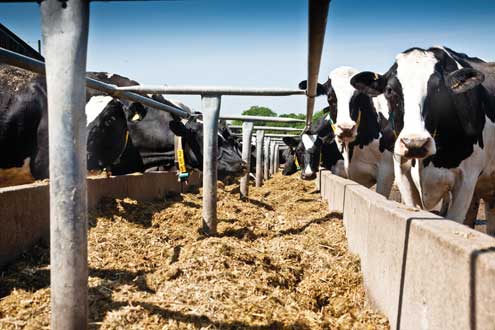Heat stress should be a hot topic for UK dairy farmers

During hot weather it is important food is freely available and accessible throughout the evening and night when intakes are likely to be higher.
By Steve Smith, PAWS Veterinary Health Centre
Heat stress in dairy cows can have significant effects upon health, production and fertility.
In the UK heat stress has been largely ignored, mainly because the weather is unpredictable and high temperatures rarely persist for long periods. So while our cows tend not to suffer from the very worst effects of heat stress, if we improve our cow management during hot periods it can pay dividends in both the long and the short term.
When is it too hot?
• When temperatures rise, cows become less efficient at regulating their body temperature.
• Cows can begin to be affected when temperatures rise above 22C (72F) and the effect is more severe at any given temperature as the humidity increases.
• High yielding cows tend to have higher dry matter intakes of rapidly fermentable feed which leads to faster and greater heat production making them more susceptible to heat stress.
• In simple terms, if you are finding your work hot and uncomfortable, you can be sure that your cows are feeling much worse.
What happens when it is too hot?
• Cows try to lose excess heat by sweating and rapid breathing. This is hard work and may increase their maintenance energy requirement by up to 20% and their water requirement by more than 50%.
• Cows slow down their rumination and cud chewing, their appetite declines and their dry matter intake may fall by 10-20%.
• If this fails to remove enough heat, the core body temperature will rise, resulting in many negative effects throughout the body and a decline in general health and fertility.
What are the effects of heat stress?
The bad effects tend to be cumulative. The longer the period of hot weather, particularly if the nights are also hot, the greater the negative effects will be.
The most immediate effect is a drop in milk yield and milk quality due to the decrease in dry matter intake and an increase in the energy required for actively losing heat. If the hot weather persists there is often a reduction in the quality of grazed forage at the same time.
Less obvious is an effect on fertility. The quality of eggs produced in the ovary and the embryo quality declines resulting in early embryo death, which is seen as a drop in conception rate. The outward expression of oestrus is also suppressed, making heat detection more difficult. Overall herd health may also decline, which may show as a rise in bulk milk cell counts.
How can we combat heat stress?
Ration formulation
During hot weather, cows will eat more at night than during the day. It is important that food is freely available and accessible throughout the evening and night.
Consider reformulating the ration with a greater energy density to counteract the reduced intake. If cows are not on a TMR, there is a danger cows will continue to eat all of the concentrates, but cut down only on their forage intake. This could result in rumen acidosis and a further fall in intakes. In this situation, increasing the energy density of the concentrates could make this worse rather than better. Anything (such as molasses) that will improve the palatability of the forage would be helpful.
Water supply
Water supply is critical. Any restriction to access will be detrimental. Cows often like to drink after milking and extra water trough space at this time can be very beneficial. Ponds can be a poor source of water in dry weather as the water can become very unpalatable.
If cows are outside during the heat of the day, consider bringing them inside or giving them access to shade. If cows are housed during hot weather, the buildings need to be well ventilated. Fans that force air in or out of the building can be helpful; however, fans that just circulate air within a building are of little value.
Some of the more general negative effects of heat stress may be due to an increased requirement for anti-oxidants. The main anti-oxidant in cattle feed is selenium. Whilst there is no specific evidence that extra selenium is necessary, any herds where selenium levels are marginal are potentially at greater risk of suffering from some of the metabolic effects of heat stress.
Hot cows need your help
Failing to take measures to help your cows to lose the excess heat that they produce can have serious financial consequences. If as an industry we continue to move toward higher yields with cows housed in the summer and global warming, fully force ventilated cow housing may become essential to success.
Managing heat stress
- Heat stress affects health, production and fertility
- Manage your ration to the condition
- Water supply and access is critical
- Are you providing shade or creating an oven?
